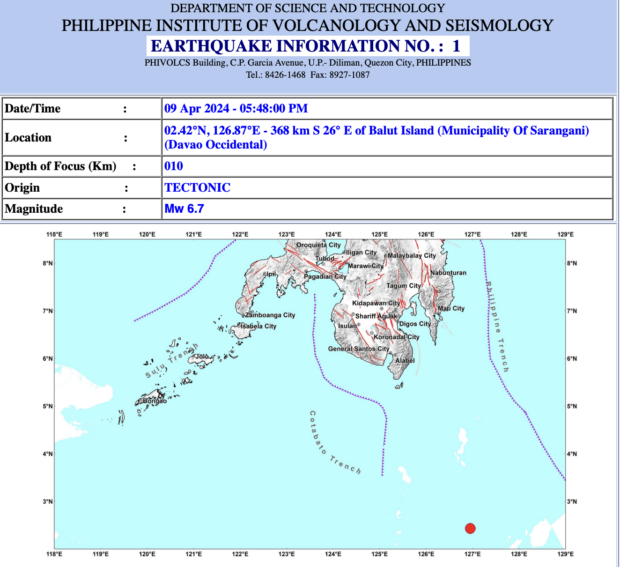Balut Island in Davao Occidental felt the tremors of a magnitude 6.7 earthquake, as reported by the Philippine Institute of Volcanology and Seismology (Phivolcs). The seismic event, occurring at 5:48 p.m., originated 368 kilometers southeast of Balut Island, Sarangani, Davao Occidental, with a depth of focus recorded at 10 kilometers. Phivolcs identified the quake as tectonic in origin, indicating movement along geological faults beneath the Earth’s surface.

Although seismic activities often evoke concern, Phivolcs reassured that no significant damage is expected from this event. Despite the tremors reaching Intensity II in Malungon, Sarangani, and Intensity I in Alabel, Glan, and Kiamba in Sarangani, as well as Don Marcelino in Davao Occidental, and the City of Digos in Davao del Sur, the impact remained minimal. These intensities primarily denote perceptible shaking but rarely lead to structural damage or casualties.
Furthermore, Phivolcs underscored that the risk of destructive tsunamis was non-existent, providing relief to coastal communities. Through meticulous monitoring and analysis of seismic data, authorities swiftly determined that no tsunami threat loomed over the affected regions. This proactive approach to disseminating information is crucial in allaying public fears and ensuring timely responses to natural disasters.
Despite the absence of significant damage or imminent threats, the possibility of aftershocks remains a concern. Aftershocks, though typically diminishing in intensity, can still induce anxiety and disrupt recovery efforts. Therefore, communities in the vicinity are advised to remain vigilant and prepared for any subsequent seismic activity. Preparedness measures, including securing loose objects, identifying safe zones, and reviewing evacuation procedures, can mitigate risks and enhance resilience in the face of such events.
This seismic event serves as a reminder of the unpredictable nature of our planet and the importance of proactive disaster preparedness. While advancements in technology enable early detection and warning systems, the resilience of communities ultimately determines the impact of natural disasters. Through continued collaboration between scientific institutions, government agencies, and local communities, we can strengthen our capacity to mitigate risks and protect lives and livelihoods in the face of adversity.
As Balut Island and surrounding areas recover from the tremors of this recent earthquake, let us remain steadfast in our commitment to fostering resilience and solidarity in the face of natural disasters. By learning from past experiences and embracing a culture of preparedness, we can build safer and more resilient communities for generations to come.
